Let It Pour!
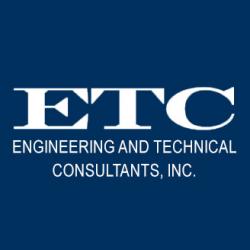
The largest concrete pour in Boston history was recently completed. Check out this time-lapse video to see what can be done in 22-1/2 hours, 572 concrete trucks, and a lot of skilled labor

The largest concrete pour in Boston history was recently completed. Check out this time-lapse video to see what can be done in 22-1/2 hours, 572 concrete trucks, and a lot of skilled labor

 Remember to never store other chemicals (cleaning products, solvents, fertilizers, deicing agents, etc.) in pool filter or pump rooms. The most widely used pool chemical is chlorine and it does not play well with others (particularly ammonia compounds). Very bad things can happen if they should mix, including creation of chlorine gas and other highly toxic substances. Ammonia is present in most fertilizers and a number of chemical deicers. Stay safe this summer and separate your chemicals!
Remember to never store other chemicals (cleaning products, solvents, fertilizers, deicing agents, etc.) in pool filter or pump rooms. The most widely used pool chemical is chlorine and it does not play well with others (particularly ammonia compounds). Very bad things can happen if they should mix, including creation of chlorine gas and other highly toxic substances. Ammonia is present in most fertilizers and a number of chemical deicers. Stay safe this summer and separate your chemicals!
It’s also worth noting that chlorine is a powerful oxidizer. That property makes chlorine an effective sanitizing agent in swimming pools but it also accelerates corrosion (rusting). If you have electrical panels, light fixtures, or other steel items that share space with chemical treatment tanks, you’ve probably see the effects.

 We are often asked about weight limitations for balconies, particularly with regard to the allowable sizes and weights of plants that may be put on the balconies. The simple answer is that it depends on exactly how the balcony was designed and built. In general, plants that are placed on balconies should not be so large or heavy that they cannot be readily moved by the average size adult.
We are often asked about weight limitations for balconies, particularly with regard to the allowable sizes and weights of plants that may be put on the balconies. The simple answer is that it depends on exactly how the balcony was designed and built. In general, plants that are placed on balconies should not be so large or heavy that they cannot be readily moved by the average size adult.
This would generally mean that an individual plant (with its pot, soil, etc.) should not weigh more than a normal adult (about 200 pounds). Plants with this type of weight limitation can often be placed throughout the balcony surface as long as a clean space of about two feet is provided between them.
Please remember that each case may vary. If you are concerned, think about having a structural engineer evaluate your specific planter layout.

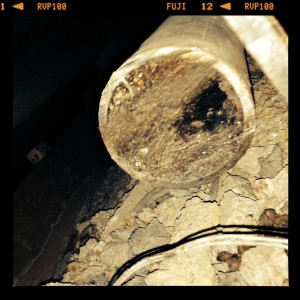 During a recent plaza repair project, we were reminded why cleaning storm drain pipes on a regular basis is a good idea. Solids, such as minerals that may leach from building materials (concrete or brick) or small fines and debris (particularly in planters), may be picked up by surface runoff and deposit into drains and corresponding drain lines. Over time, these deposits may congest the drain pipe, which leads to blockages and decreased drainage flow. Severe build ups may become hardened to the point where replacement of the pipe is the only option to restore proper drainage.
During a recent plaza repair project, we were reminded why cleaning storm drain pipes on a regular basis is a good idea. Solids, such as minerals that may leach from building materials (concrete or brick) or small fines and debris (particularly in planters), may be picked up by surface runoff and deposit into drains and corresponding drain lines. Over time, these deposits may congest the drain pipe, which leads to blockages and decreased drainage flow. Severe build ups may become hardened to the point where replacement of the pipe is the only option to restore proper drainage.
In order to prevent solid build-ups and pipe replacement, it is important that drain lines, particularly those serving roofs, terraces, plazas, and garages, be hydro-jet cleaned every few years. The hydro-jet cleaning process utilizes high pressure streams of water to remove the solid deposits from the pipe walls and returns the pipe to a free flowing condition. Cleaning drain lines as part of a regular preventative maintenance plan is an effective way to extend the service life of your drain lines and inspect pipe conditions, which may prevent large (expensive) replacement projects in the future

This past weekend, our senior staff took a couple of days to meet and discuss the needs of our clients and how we can better serve them. This is nothing we take lightly, so it was two full days of discussions on new ideas, technology, training and much more. Putting our great minds together, in one room, resulted in some appealing new concepts we look forward to rolling out in the near future.

We have come across some really poor quality welds recently, which were performed by companies claiming to use qualified welders. We do not know if the welders just 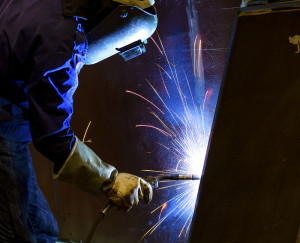 had a bad day or they were not certified for the welds being performed. This highlights the need to use American Welding Society (AWS) Certified Welders with currently active credentials. To become certified, the welder must pass a welding test for all of the welds he intends to perform. Just because a welder passes a test to weld plates together does not mean he can weld pipes. So you need to look at their certifications closely. Additionally, AWS requires that every six months the “welder” submit proof that they are still actively engaged in welding. AWS issues a certification card and your weld should be able to provide an AWS form that shows all the welds that he is qualified to make. For more information visit the AWS website http://www.aws.org/certification/CW/
had a bad day or they were not certified for the welds being performed. This highlights the need to use American Welding Society (AWS) Certified Welders with currently active credentials. To become certified, the welder must pass a welding test for all of the welds he intends to perform. Just because a welder passes a test to weld plates together does not mean he can weld pipes. So you need to look at their certifications closely. Additionally, AWS requires that every six months the “welder” submit proof that they are still actively engaged in welding. AWS issues a certification card and your weld should be able to provide an AWS form that shows all the welds that he is qualified to make. For more information visit the AWS website http://www.aws.org/certification/CW/

Do you have light poles on your property that look like this? We know of some poles that have fallen during storms. 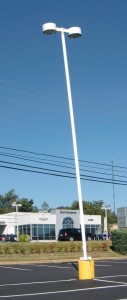 Why risk possible property damage or a life safety condition? Not all defects are this obvious. We can inspect light/utility poles for corrosion lurking inside that may not manifest until one smashes the roof of the only Rolls Royce in the lot.
Why risk possible property damage or a life safety condition? Not all defects are this obvious. We can inspect light/utility poles for corrosion lurking inside that may not manifest until one smashes the roof of the only Rolls Royce in the lot.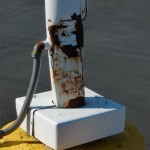

 The future of concrete demolition in buildings may be seen in this robot that recently won an outstanding design award in Sweden. According to the designer this robot can demolish concrete and leave the steel reinforcement in place, while capturing the dust it creates and recycling the concrete. The link below includes more information about this innovation that may soon be seen at a concrete repair project near you
The future of concrete demolition in buildings may be seen in this robot that recently won an outstanding design award in Sweden. According to the designer this robot can demolish concrete and leave the steel reinforcement in place, while capturing the dust it creates and recycling the concrete. The link below includes more information about this innovation that may soon be seen at a concrete repair project near you
http://inhabitat.com/amazing-ero-concrete-recycling-robot-can-erase-entire-buildings/

 If you’ve ever read an engineering report you’ve probably encountered a lot of acronyms. Here are some we frequently mention, with short explanations of what they mean. For the sake of brevity, we’ve only described items as they relate to building construction.
If you’ve ever read an engineering report you’ve probably encountered a lot of acronyms. Here are some we frequently mention, with short explanations of what they mean. For the sake of brevity, we’ve only described items as they relate to building construction.
APA – The Engineered Wood Association, formerly known as the American Plywood Association. They define standards for the production of plywood and other engineered wood products used in construction.
ARMA – Asphalt Roofing Manufacturers Association is a trade organization that defines the standards for the manufacture of and uses for asphalt roofing products.
ASTM – Now known as ASTM International, ASTM formerly stood for American Society for testing and materials. They define consensus standards for testing the majority of products manufactured in the United States and other participant countries.
BIA – Brick Industry Association , formerly known as the Brick Institute of America, defines the standards for brick masonry construction and repair.
BOCA – Building Officials and Code Administrators developed model building codes used primarily on the east coast and in the mid-west of the United States. Similar organizations developed codes for other regions of the country until the major organizations merged to form the International Code Council (ICC).
IBC – International Building Code is the model code published by the ICC.
EIFS – Exterior insulating and finish system is a synthetic stucco typically comprised of a layer expanded polystyrene insulation attached to a building wall and surfaced with a cementitious coating.
EPDM – Ethylene propylene diene monomer is a synthetic rubber used in the manufacture of roofing and waterproofing membranes.
ICRI – International Concrete Repair Institute is a trade organization that defines standards for the repair of concrete.
NRCA – National Roofing Contractors National Association is a trade organization comprised primarily of roofing contractors and design professionals, in an associate capacity. They define the standards for roof design and installation.
PVC – Polyvinyl chloride is a thermoplastic used in the manufacture of numerous items used in construction, including water conductors, floor coverings, and roofing and waterproofing membranes.

 Hardly a day passes when the inbox doesn’t include an advertisement for some miraculous new product, guaranteed to stop leaks forever, eliminate maintenance and otherwise make our lives easier. Property managers and owners must be on the same mailing lists because we encounter a fair number of these products in the field (usually soon after they were installed or applied) when we’re retained to figure out why they don’t work.
Hardly a day passes when the inbox doesn’t include an advertisement for some miraculous new product, guaranteed to stop leaks forever, eliminate maintenance and otherwise make our lives easier. Property managers and owners must be on the same mailing lists because we encounter a fair number of these products in the field (usually soon after they were installed or applied) when we’re retained to figure out why they don’t work.
The advertising literature for these items is often well presented and convincing and as a society we are enamored of “cutting edge” technology. The principles described seem logical and the price is usually attractive. After all, it would be foolish to replace that $100,000 roof when $1,000 worth of “MIRACUWONDROUS WATER DEFEATER” will fix all your problems at a fraction of the cost.
It would be unfair and inaccurate to say that all products that claim to be “breakthrough” or “miraculous” are worthless. Some may actually perform useful functions under specific circumstances; however extreme skepticism should be your rule when considering new, untested technologies or unorthodox remedies. You don’t want to be the “lab rat”.
The fact is that new technologies are introduced all the time and some will be revolutionary. It’s also true that new products are seldom completely successful in their initial incarnations. Second and third generation products usually improve on the first and succeeding generations tend to get even better. Of course, in some cases the only thing that improves is the marketing. In other cases, the product began as garbage and even quantum improvements can’t elevate it above that status.
The time may come when force-fields replace conventional roofing and magic comes in a can. Our advice is to wait until they have proven effective in field applications rather than being the test case in what could be a costly experiment.